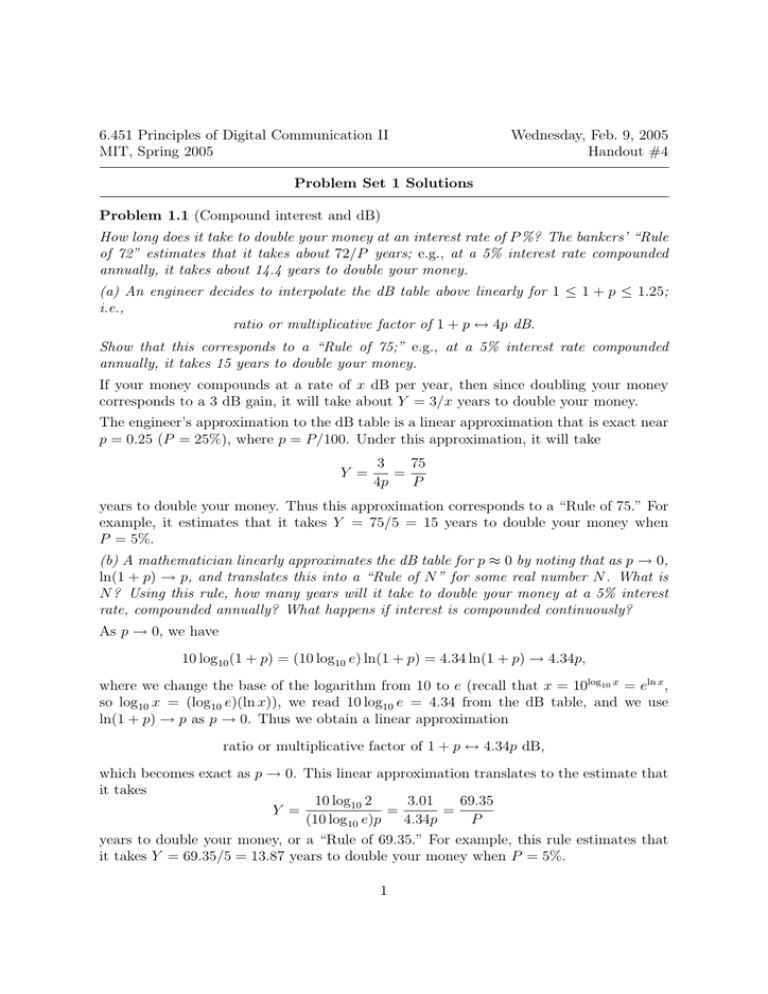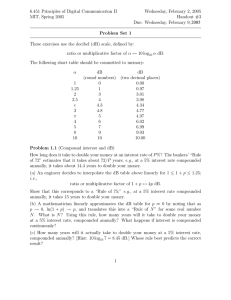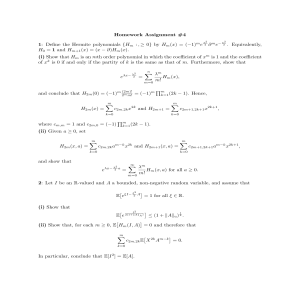Document 13512764
advertisement

6.451 Principles of Digital Communication II
MIT, Spring 2005
Wednesday, Feb. 9, 2005
Handout #4
Problem Set 1 Solutions
Problem 1.1 (Compound interest and dB)
How long does it take to double your money at an interest rate of P %? The bankers’ “Rule
of 72” estimates that it takes about 72/P years; e.g., at a 5% interest rate compounded
annually, it takes about 14.4 years to double your money.
(a) An engineer decides to interpolate the dB table above linearly for 1 ≤ 1 + p ≤ 1.25;
i.e.,
ratio or multiplicative factor of 1 + p ↔ 4p dB.
Show that this corresponds to a “Rule of 75;” e.g., at a 5% interest rate compounded
annually, it takes 15 years to double your money.
If your money compounds at a rate of x dB per year, then since doubling your money
corresponds to a 3 dB gain, it will take about Y = 3/x years to double your money.
The engineer’s approximation to the dB table is a linear approximation that is exact near
p = 0.25 (P = 25%), where p = P/100. Under this approximation, it will take
Y =
75
3
=
4p
P
years to double your money. Thus this approximation corresponds to a “Rule of 75.” For
example, it estimates that it takes Y = 75/5 = 15 years to double your money when
P = 5%.
(b) A mathematician linearly approximates the dB table for p ≈ 0 by noting that as p → 0,
ln(1 + p) → p, and translates this into a “Rule of N ” for some real number N . What is
N ? Using this rule, how many years will it take to double your money at a 5% interest
rate, compounded annually? What happens if interest is compounded continuously?
As p → 0, we have
10 log10 (1 + p) = (10 log10 e) ln(1 + p) = 4.34 ln(1 + p) → 4.34p,
where we change the base of the logarithm from 10 to e (recall that x = 10log10 x = eln x ,
so log10 x = (log10 e)(ln x)), we read 10 log10 e = 4.34 from the dB table, and we use
ln(1 + p) → p as p → 0. Thus we obtain a linear approximation
ratio or multiplicative factor of 1 + p ↔ 4.34p dB,
which becomes exact as p → 0. This linear approximation translates to the estimate that
it takes
69.35
3.01
10 log10 2
=
=
Y =
(10 log10 e)p
4.34p
P
years to double your money, or a “Rule of 69.35.” For example, this rule estimates that
it takes Y = 69.35/5 = 13.87 years to double your money when P = 5%.
1
A more precise calculation using natural logarithms yields
Y =
ln 2
69.31
=
,
p
P
or a “Rule of 69.31,” which estimates that it takes Y = 69.31/5 = 13.86 years to double
your money when P = 5%.
Remark. Note that this “Rule of 69.31” becomes exact when interest is compounded
continuously, so that after Y years your money has increased by a factor of epY , rather
than the factor of (1 + p)Y that you get when interest is compounded annually.
(c) How many years will it actually take to double your money at a 5% interest rate,
compounded annually? [Hint: 10 log10 7 = 8.45 dB.] Whose rule best predicts the correct
result?
Since 1.05 = 21/20, a factor of 1.05 is equivalent to
10 log10 7 + 10 log10 3 − 10 log10 10 − 10 log10 2 = 8.45 + 4.77 − 10 − 3.01 = 0.21 dB.
Thus it actually takes
3.01
= 14.33
0.21
years to double your money when interest is compounded annually.
Y =
We see that this estimate is quite close to the estimate of Y = 14.4 years given by the
“Rule of 72.” Thus the “Rule of 72” is equivalent to a linear approximation of the dB
table that is exact near P = 5%. This is the range in which the “Rule of 72” is commonly
used. The “Rule of 72” also has the advantage that 72 has many integer divisors (e.g., 2,
3, 4, 6, 8, 9, 12, . . . ), so that its estimate of Y is an easily calculated integer for many
common interest rates. So in this instance the bankers have been rather clever.
Problem 1.2 (Biorthogonal codes)
A 2m × 2m {±1}-valued Hadamard matrix H2m may be constructed recursively as the
m-fold tensor product of the 2 × 2 matrix
+1 +1
,
H2 =
+1 −1
as follows:
H 2m =
+H2m−1 +H2m−1
+H2m−1 −H2m−1
.
(a) Show by induction that:
(i) (H2m )T = H2m , where
T
denotes the transpose; i.e., H2m is symmetric;
(ii) The rows or columns of H2m form a set of mutually orthogonal vectors of length 2m ;
(iii) The first row and the first column of H2m consist of all +1s;
2
(iv) There are an equal number of +1s and −1s in all other rows and columns of H2m ;
(v) H2m H2m = 2m I2m ; i.e., (H2m )−1 = 2−m H2m , where
−1
denotes the inverse.
We first verify that (i)-(v) hold for H2 . We then suppose that (i)-(v) hold for H2m−1 . We
can then conclude by induction that:
(i)
T
(H2m ) =
+(H2m−1 )T +(H2m−1 )T
+(H2m−1 )T −(H2m−1 )T
=
+H2m−1 +H2m−1
+H2m−1 −H2m−1
= H 2m .
(ii) The first 2m−1 rows of H2m are of the form hj = (gj , gj ), where gj is the corresponding
row of H2m−1 , and the second 2m−1 rows of H2m are of the form hj+2m−1 = (gj , −gj ).
Suppose that the rows gj of H2m−1 are mutually orthogonal. Then the inner product
hj , hj is 0 whenever j = j and j =
j ± 2m−1 , because the inner product is the
sum of the inner products of the first half-rows and the second half-rows, which are
both zero. If j = j − 2m−1 , then the inner product is
hj , hj = gj , gj + gj , −gj = gj , gj − gj , gj = 0,
and similarly hj , hj = 0 when j = j + 2m−1 . Thus hj , hj = 0 whenever j = j ,
so the rows of H2m form a set of mutually orthogonal vectors. Since (H2m )T = H2m ,
so do the columns.
(iii) The first row of H2m is h0 = (g0 , g0 ), where g0 is the first row of H2m−1 . By the
inductive hypothesis, g0 = (+1, +1, . . . , +1), so h0 = (+1, +1, . . . , +1); i.e., all
columns of H2m have a +1 as their first component. Since (H2m )T = H2m , so do all
the rows.
(iv) The remaining rows of H2m are orthogonal to h0 by (ii), and thus must have an equal
number of +1s and −1s. Since (H2m )T = H2m , so must the remaining columns.
(v) Since (H2m )T = H2m , the matrix H2m H2m = H2m (H2m )T is the matrix of inner
products of rows of H2m . By (ii), all off-diagonal elements of this matrix are zero.
The diagonal elements are the squared norms ||hj ||2 = 2m , since hj is a vector of
length 2m in which each component has squared norm 1. Thus H2m H2m = 2m I2m .
(b) A biorthogonal signal set is a set of real equal-energy orthogonal vectors and their
negatives. Show how to construct a biorthogonal signal set of size 64 as a set of {±1}valued sequences of length 32.
By (a)(ii), the rows of H32 form a set O of 32 orthogonal {±1}-valued sequences of length
32, each with energy 32. It follows that the rows of H32 and their negatives form a
biorthogonal set B = ±O of 64 {±1}-valued sequences of length 32.
3
(c) A simplex signal set S is a set of real equal-energy vectors that are equidistant and
that have zero mean m(S) under an equiprobable distribution. Show how to construct a
simplex signal set of size 32 as a set of 32 {±1}-valued sequences of length 31. [Hint: The
fluctuation O − m(O) of a set O of orthogonal real vectors is a simplex signal set.]
As in (b), the rows of H32 form a set O of 32 orthogonal equal-energy (and therefore
equidistant) {±1}-valued sequences of length 32. By (a)(iii)-(iv), the mean of O is m(O) =
(+1, 0, 0, . . . , 0), since all rows have +1 in the first column and an equal number of +1s
and −1s in the remaining columns. Thus S = O − m(O) is a zero-mean, equal-energy and
equidistant set of 32 row vectors of length 32 which have 0 in the first coordinate and the
elements of the rows of H32 in the remaining coordinates. Since the first coordinate always
has value 0, it may be deleted without affecting any norms, distances or inner products; in
particular, the vectors remain zero-mean, equal-energy and equidistant. Thus we obtain
a simplex signal set S consisting of a set of 32 {±1}-valued sequences of length 31.
(d) Let Y = X + N be the received sequence on a discrete-time AWGN channel, where
the input sequence X is chosen equiprobably from a biorthogonal signal set B of size 2m+1
constructed as in part (b). Show that the following algorithm implements a minimumdistance decoder for B (i.e., given a real 2m -vector y, it finds the closest x ∈ B to y):
(i) Compute z = H2m y, where y is regarded as a column vector;
(ii) Find the component zj of z with largest magnitude |zj |;
(iii) Decode to sgn(zj )xj , where sgn(zj ) is the sign of the largest-magnitude component zj
and xj is the corresponding column of H2m .
Given y, minimizing the squared distance ||y−x||2 over x ∈ B is equivalent to maximizing
the inner product y, x, since
||y − x||2 = ||y||2 − 2y, x + ||x||2 ,
and ||x||2 is equal to a constant (2m ) for all x ∈ B. The vector z = H2m y is the set of
inner products y, x as x runs through the 2m rows of H2m . The set of inner products
y, x as x runs through the 2m+1 elements of B are therefore just the elements of z and
their negatives. Maximizing y, x is therefore equivalent to finding the element zj of z
with largest magnitude |zj |, and deciding on the corresponding row xj of H2m if the sign
of zj is positive, or on −xj if the sign is negative.
Remark. Note that the matrix multiplication z = H2m y corresponds to implementing a
bank of matched filters, one for each of the rows of H2m , which form the set of correlations
of y with each of the rows of H2m . Since the rows of H2m span the signal space S ⊃ B, by
the theorem of irrelevance (see Chapter 2) the outputs z of this bank of matched filters
form a set of sufficient statistics for detection of a signal x ∈ S in the presence of AWGN.
In this case we have been able to show directly that we can find an optimal decision rule
based on z which is very simple.
4
(e) Show that a circuit similar to that shown in Figure 1 below for m = 2 can implement the 2m × 2m matrix multiplication z = H2m y with a total of only m × 2m addition
and subtraction operations. (This is called the “fast Hadamard transform,” or “Walsh
transform,” or “Green machine.”)
y1
y2
y3
y4
-
+A -+
�
@
R
A-
�- − A A +
- A-AU
+
A −
@�
AU
R
@
�- − - −
@
-
z1
-
z2
-
z3
-
z4
Figure 1. Fast 2m × 2m Hadamard transform for m = 2.
This
⎡
z1
⎢ z2
⎢
⎣ z3
z4
circuit is based on the following recursion for z = H4 y:
⎤ ⎡ ⎤
⎡
⎤ ⎡
y
y
y
y1
1
3
1
+ H2
+
+H2
⎥
⎥
⎢
⎢
⎥
⎢
⎥ = +H2 +H2 ⎢ y2 ⎥ = ⎢
y2 y4 ⎥ = ⎢ y2 ⎦
y1
+H2 −H2 ⎣ y3 ⎦ ⎣
y3 ⎦ ⎣ y1
+H2
−
− H2
y4
y2
y2
y4
⎤
y3
y4 ⎥
⎥
⎦.
y3
y4
In other words, we first group the elements of y into pairs (y1 , y2 ), (y3 , y4 ), . . . . The first
set of arithmetic elements computes the 2 × 2 Walsh-Hadamard transform of each pair;
e.g.,
y
1
y1
y1 + y2
= H2
=
.
y
2
y2
y1 − y2
We then group the elements of y into pairs (y1 , y3 ), (y2 , y4 ), . . . , and again compute the
2 × 2 Walsh-Hadamard transform of each pair; e.g.,
z1
y1
y1 + y3
= H2
=
.
z3
y3
y1 − y
3
Thus we can compute the 4 × 4 Walsh-Hadamard transform z = H4 y by computing two
stages of two 2 × 2 Walsh-Hadamard transforms, as illustrated in Figure 1.
Similarly, we can compute a 2m × 2m Walsh-Hadamard transform z = H2m y using the
recursion
z0
+H2m−1 +H2m−1
y0
H2m−1 y0 + H2m−1 y1
=
=
,
z1
+H2m−1 −H2m−1
y1
H2m−1 y0 − H2m−1 y1
by computing two 2m−1 × 2m−1 Walsh-Hadamard transforms, and then combining their
outputs in one more stage involving 2m−1 2 × 2 Walsh-Hadamard transforms. If each
2m−1 × 2m−1 Walsh-Hadamard transform requires m − 1 stages of 2m−2 2 × 2 WalshHadamard transforms, then the 2m × 2m Walsh-Hadamard transform requires m stages of
2m−1 2 × 2 Walsh-Hadamard transforms. Each 2 × 2 transform requires one addition and
one subtraction, so a total of only m × 2m−1 × 2 additions and subtractions is required.
Thus the complexity of an M = 2m -point Walsh-Hadamard transform is only of the order
of M log2 M , rather than M 2 . This is why this algorithm is called “fast.”
5
Problem 1.3 (16-QAM signal sets)
Three 16-point 2-dimensional quadrature amplitude modulation (16-QAM) signal sets are
shown in Figure 2, below. The first is a standard 4 × 4 signal set; the second is the
V.29 signal set; the third is based on a hexagonal grid and is the most power-efficient
16-QAM signal set known. The first two have 90◦ symmetry; the last, only 180◦ . All have
a minimum squared distance between signal points of d2min = 4.
r
r
r
r
r
r
r
r
r
−3 −1
r
r
r
r
1
3
r
r
r
r
r
r
r
r
−5r −3r −1
1
r
r
r
r
r
(a)
(b)
3r
r
√
2 3
√
r
r
r
r
3
−2.r5−0.r5 1.r5 3.r5
√
r
r
r
r− 3
√
r
r −2 3
r
r
5r
r
(c)
Figure 2. 16-QAM signal sets. (a) (4 × 4)-QAM; (b) V.29; (c) hexagonal.
(a) Compute the average energy (squared norm) of each signal set if all points are equiprobable. Compare the power efficiencies of the three signal sets in dB.
In Figure 2(a), there are 4 points with squared norm 2, 8 with squared norm 10, and 4
with squared norm 18, so
1
1
1
Ea = 2 + 10 + 18 = 10 (10.00 dB).
4
2
4
Alternatively, both coordinates have equal probability of having squared norm 1 or 9, so
the average energy per coordinate is 5, and thus Ea = 10. In Figure 2(b), there are 4 points with squared norm 2, 4 with squared norm 9, 4 with
squared norm 18, and 4 with squared norm 25, so
1
1
1
1
Eb = 2 + 9 + 18 + 25 = 13.5 (11.30 dB).
4
4
4
4
Thus this signal set is 1.3 dB less power-efficient than that of Figure 2(a).
In Figure 2(c), there is 1 point with squared norm 1/4, 1 with 9/4, 2 with 13/4, 2 with
21/4, 1 with 25/4, 2 with 37/4, 3 with 49/4, 2 with 57/4 and 2 with 61/4, so
Ec =
1 + 9 + 26 + 42 + 25 + 74 + 147 + 114 + 122
= 8.75 (9.42 dB).
4 × 16
Thus this signal set is about 0.6 dB more power-efficient than that of Figure 2(a).
Remark. A more elegant way of doing this calculation is to shift the origin by (1/2, 0)
to the least-energy point. The resulting signal set has mean (1/2, 0), and 1 point with
squared norm 0, 6 with 4, 6 with 12, and 3 with 16, for an average of 9. Subtracting the
squared norm 1/4 of its mean, we get Ec = 8.75 (9.42 dB) for the zero-mean signal set of
Figure 2(c).
6
(b) Sketch the decision regions of a minimum-distance detector for each signal set.
The minimum-distance decision regions are sketched below for Figures 2(a) and 2(b). For
Figure 2(c), the decision regions for signals in the interior of the constellation are hexagons
(and are hard to draw in LATEX).
Note that in Figure 2(a) the minimum-distance decision regions correspond to two independent minimum-distance decisions on each 4-PAM coordinate.
r
JJ
r
r
r
r
r
r
r
H
@
Q
H
Q
�
r
r r
r
r
r
A
r A
r
r
r
r
r A
r
r
r
r
A
Q
HH�
Q
@
r
r
r
r
r
r
r
r J
J
(a)
(b)
r
r
r
r
r
r
r
r
r
r
r
r
r
r
r
r
(c)
We also draw 2-spheres (circles) of radius 1 about each signal point. The fact that these
2-spheres are disjoint except where they kiss (at their points of tangency) shows that
dmin = 2. This makes it obvious that 2(a) is more densely packed (more power-efficient)
than 2(b), and in turn that 2(c) is more densely packed than 2(a). In fact, 2(c) might well
be what we would come up with if we took 16 pennies and tried to pack them together
as densely as possible.
Since Gaussian noise is circularly symmetric and its probability density decreases exponentially with distance, the dominant types of errors in AWGN will be those that occur
at the points of tangency of these 2-spheres, which lie on decision region boundaries.
Remark. Figure 2(b) could obviously be made somewhat more power-efficient without
changing its essential character by somewhat decreasing the radii of its outer points until
their associated 2-spheres become tangent to innermore 2-spheres.
(c) Show that with a phase rotation of ±10◦ the minimum distance from any rotated signal
point to any decision region boundary is substantially greatest for the V.29 signal set.
The question here is: if each signal point x = (x, y) is rotated by a small angle θ to a
rotated point x = (x cos θ − y sin θ, y cos θ + x sin θ), what is the worst-case reduction in
distance to the nearest decision boundary?
For small phase rotations (|θ| ≤ 10◦ ), we may use the approximations cos θ ≈ 1, sin θ ≈ θ,
or x ≈ (x − θy, y + θx).
For Figure 2(a), a rotation of either a point of type (3, 1) or of type (3, 3) by a small angle
θ therefore reduces the distance to the nearest decision boundary by approximately 3θ, or
by approximately 0.5 when |θ| ≈ 10◦ . Thus the minimum distance to a decision boundary
is cut approximately by a factor of 2, or the minimum squared distance by a factor of 4,
which we will see later amounts to a reduction of about 6 dB in signal-to-noise margin.
7
For Figure 2(b), all of the outer points have enough distance from their nearest decision
boundaries in the tangential direction so that the minimum distance is still at least 1 after
a 10◦ rotation. For example, a point of type (3, 0) rotates approximately to (3, 0.5), which
is still distance 1 from the nearest point (3, 1.5) on the decision boundary. The worst
case is therefore an inner point of type (1, 1), whose minimum distance of 1 is reduced by
about 0.17 by a 10◦ rotation. Since (0.83)2 is about 1.6 dB, this amounts to about a 1.6
dB reduction in signal-to-noise margin. Thus even though the Figure 2(b) signal set has
1.3 worse signal-to-noise margin to start with, in the presence of uncompensated ±10◦
phase rotations (“phase jitter”) it becomes more than 3 dB better than Figure 2(a).
For Figure 2(c), it is clear that the outer points are affected by
√ phase rotations similarly
to the outer points of 2(a). For example, a point of type (2.5, 3) has squared norm 9.25
and thus radius 3.04. A phase rotation of θ moves it directly by an amount 3.04θ toward
its nearest decision boundary, so as in 2(a) a rotation of about θ = 10◦ cuts the distance
to the nearest decision boundary by a factor of about 2, for a reduction in SNR margin
of about 6 dB.
Problem 1.4 (Shaping gain of spherical signal sets)
In this exercise we compare the power efficiency of n-cube and n-sphere signal sets for
large n.
An n-cube signal set is the set of all odd-integer sequences of length n within an n-cube
of side 2M centered on the origin. For example, the signal set of Figure 2(a) is a 2-cube
signal set with M = 4.
An n-sphere signal set is the set of all odd-integer sequences of length n within an nsphere of squared radius r2 centered on the origin. For example, the signal set of Figure
3(a) is also a 2-sphere signal set for any squared radius r2 in the range 18 ≤ r2 < 25.
In particular, it is a 2-sphere signal set for r2 = 64/π = 20.37, where the area πr2 of
the 2-sphere (circle) equals the area (2M )2 = 64 of the 2-cube (square) of the previous
paragraph.
Both n-cube and n-sphere signal sets therefore have minimum squared distance between
signal points d2min = 4 (if they are nontrivial), and n-cube decision regions of side 2 and
thus volume 2n associated with each signal point. The point of the following exercise is to
compare their average energy using the following large-signal-set approximations:
• The number of signal points is approximately equal to the volume V (R) of the bounding n-cube or n-sphere region R divided by 2n , the volume of the decision region
associated with each signal point (an n-cube of side 2).
• The average energy of the signal points under an equiprobable distribution is approximately equal to the average energy E(R) of the bounding n-cube or n-sphere region
R under a uniform continuous distribution.
8
(a) Show that if R is an n-cube of side 2M for some integer M , then under the two
above approximations the approximate number of signal points is M n and the approximate
average energy is nM 2 /3. Show that the first of these two approximations is exact.
The first approximation is that the number mcube of signal points is approximately
V (R)
(2M )n
=
= M n.
n
n
2
2
This approximation is exact, because it can be seen that an n-cube constellation of side
2M is simply the n-fold Cartesian product An = {(x1 , x2 , . . . , xn ) | xk ∈ A} of an M PAM costellation A = {±1, ±3, . . . , ±(M − 1)}, the set of all odd integers in the interval
[−M, M ]. (For example, Figure 2(a) is the 2-fold Cartesian product A2 of a 4-PAM
constellation A.)
mcube ≈
The second approximation is that the average energy Ecube is approximately
Ecube ≈ E(R) = n(M 2 /3),
where we observe that the average energy over an n-cube R of side 2M under an equiprobable distribution p(x), whose marginals are the uniform distributions p(xk ) = 1/2M , is
n M
M2
2M 3 1
2
=n
.
E(R) =
||x|| p(x)dx =
x2k p(xk )dxk = n
3 2M
3
R
k=1 −M
(In this case the exact expression is
M2 − 1
,
3
since the constellation An is the n-fold Cartesian product of an M -PAM constellation A
whose average energy is EA = (M 2 − 1)/3.)
Ecube = n
(b) For n even, if R is an n-sphere of radius r, compute the approximate number of signal
points and the approximate average energy of an n-sphere signal set, using the following
known expressions for the volume V⊗ (n, r) and the average energy E⊗ (n, r) of an n-sphere
of radius r:
(πr2 )n/2
;
(n/2)!
nr2
E⊗ (n, r) =
.
n+2
V⊗ (n, r) =
The first approximation is that the number msphere of signal points is approximately
msphere ≈
(πr2 )n/2
V (R)
=
.
2n
2n (n/2)!
The second approximation is that the average energy Esphere is approximately
Esphere ≈ E(R) =
9
nr2
.
n+2
(c) For n = 2, show that a large 2-sphere signal set has about 0.2 dB smaller average
energy than a 2-cube signal set with the same number of signal points.
In general, in n dimensions, to make mcube = msphere we choose M and r so that
Mn =
i.e.,
M2 =
(πr2 )n/2
;
2n (n/2)!
πr2
.
22 ((n/2)!)2/n
Then the ratio of the average energy of the n-cube to that of the n-sphere is
Ecube
π(n + 2)
n + 2 nM 2
=
=
.
2
Esphere
nr
3
12((n/2)!)2/n
For example, for n = 2, setting the volumes equal, (2M )2 = πr2 , we have
π
Ecube
= (0.20 dB).
Esphere
3
Thus in two dimensions using a large circular rather than square constellation saves only
about 0.2 dB in power efficiency.
(d) For n = 16, show that a large 16-sphere signal set has about 1 dB smaller average
energy than a 16-cube signal set with the same number of signal points. [Hint: 8! = 40320
(46.06 dB).]
For n = 16, however, we have
18π
3π
1
Ecube
=
=
= (4.77 + 4.97 − 3.01 − 46.06) = 0.97 dB;
1/8
1/8
Esphere
12(8!)
2(40320)
8
i.e., using a 16-sphere rather than 16-cube constellation saves nearly 1 dB in power
efficiency (signal-to-noise margin).
(e) Show that as n → ∞ a large n-sphere signal set has a factor of πe/6 (1.53 dB) smaller
average energy than an n-cube signal set with the same number of signal points. [Hint:
Use Stirling’s approximation, m! → (m/e)m as m → ∞.]
Using the hint, as n → ∞ we have
((n/2)!)2/n →
Therefore
n
.
2e
π(n + 2)
πe
Ecube
πe(n + 2)
=
(1.53 dB).
→
→
2/n
Esphere
12((n/2)!)
6n
6
Since the ratio is monotonically increasing, we conclude that the greatest possible gain in
any number of dimensions is 1.53 dB.
10







